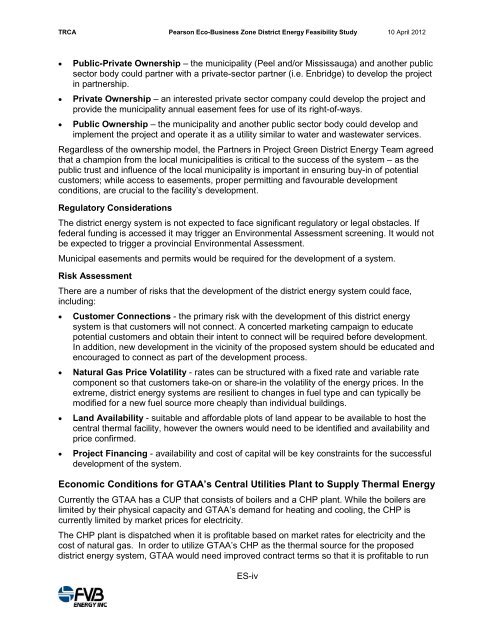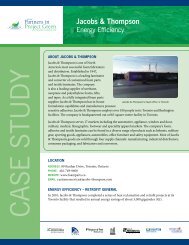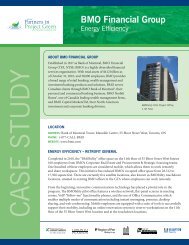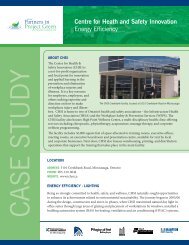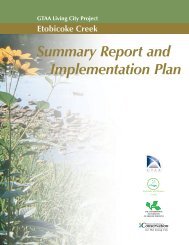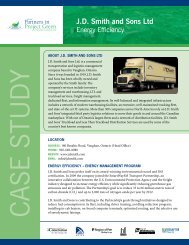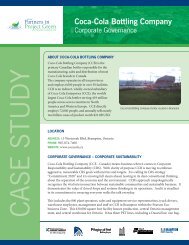Project Green District Energy Feasibility Study - Partners in Project ...
Project Green District Energy Feasibility Study - Partners in Project ...
Project Green District Energy Feasibility Study - Partners in Project ...
Create successful ePaper yourself
Turn your PDF publications into a flip-book with our unique Google optimized e-Paper software.
TRCA Pearson Eco-Bus<strong>in</strong>ess Zone <strong>District</strong> <strong>Energy</strong> <strong>Feasibility</strong> <strong>Study</strong> 10 April 2012<br />
• Public-Private Ownership – the municipality (Peel and/or Mississauga) and another public<br />
sector body could partner with a private-sector partner (i.e. Enbridge) to develop the project<br />
<strong>in</strong> partnership.<br />
• Private Ownership – an <strong>in</strong>terested private sector company could develop the project and<br />
provide the municipality annual easement fees for use of its right-of-ways.<br />
• Public Ownership – the municipality and another public sector body could develop and<br />
implement the project and operate it as a utility similar to water and wastewater services.<br />
Regardless of the ownership model, the <strong>Partners</strong> <strong>in</strong> <strong>Project</strong> <strong>Green</strong> <strong>District</strong> <strong>Energy</strong> Team agreed<br />
that a champion from the local municipalities is critical to the success of the system – as the<br />
public trust and <strong>in</strong>fluence of the local municipality is important <strong>in</strong> ensur<strong>in</strong>g buy-<strong>in</strong> of potential<br />
customers; while access to easements, proper permitt<strong>in</strong>g and favourable development<br />
conditions, are crucial to the facility’s development.<br />
Regulatory Considerations<br />
The district energy system is not expected to face significant regulatory or legal obstacles. If<br />
federal fund<strong>in</strong>g is accessed it may trigger an Environmental Assessment screen<strong>in</strong>g. It would not<br />
be expected to trigger a prov<strong>in</strong>cial Environmental Assessment.<br />
Municipal easements and permits would be required for the development of a system.<br />
Risk Assessment<br />
There are a number of risks that the development of the district energy system could face,<br />
<strong>in</strong>clud<strong>in</strong>g:<br />
• Customer Connections - the primary risk with the development of this district energy<br />
system is that customers will not connect. A concerted market<strong>in</strong>g campaign to educate<br />
potential customers and obta<strong>in</strong> their <strong>in</strong>tent to connect will be required before development.<br />
In addition, new development <strong>in</strong> the vic<strong>in</strong>ity of the proposed system should be educated and<br />
encouraged to connect as part of the development process.<br />
• Natural Gas Price Volatility - rates can be structured with a fixed rate and variable rate<br />
component so that customers take-on or share-<strong>in</strong> the volatility of the energy prices. In the<br />
extreme, district energy systems are resilient to changes <strong>in</strong> fuel type and can typically be<br />
modified for a new fuel source more cheaply than <strong>in</strong>dividual build<strong>in</strong>gs.<br />
• Land Availability - suitable and affordable plots of land appear to be available to host the<br />
central thermal facility, however the owners would need to be identified and availability and<br />
price confirmed.<br />
• <strong>Project</strong> F<strong>in</strong>anc<strong>in</strong>g - availability and cost of capital will be key constra<strong>in</strong>ts for the successful<br />
development of the system.<br />
Economic Conditions for GTAA’s Central Utilities Plant to Supply Thermal <strong>Energy</strong><br />
Currently the GTAA has a CUP that consists of boilers and a CHP plant. While the boilers are<br />
limited by their physical capacity and GTAA’s demand for heat<strong>in</strong>g and cool<strong>in</strong>g, the CHP is<br />
currently limited by market prices for electricity.<br />
The CHP plant is dispatched when it is profitable based on market rates for electricity and the<br />
cost of natural gas. In order to utilize GTAA’s CHP as the thermal source for the proposed<br />
district energy system, GTAA would need improved contract terms so that it is profitable to run<br />
ES-iv


